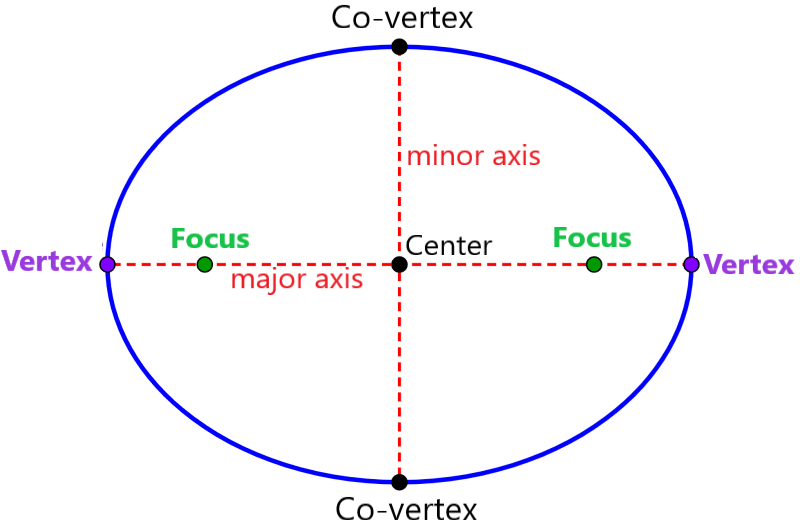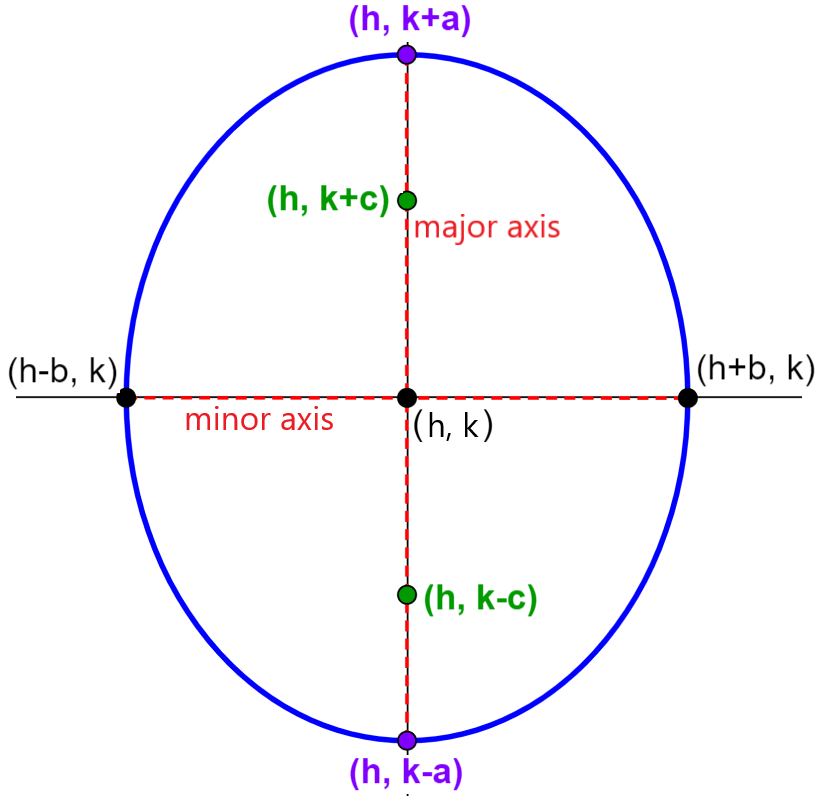The ellipse is a conic section that is formed when a plane intersects a cone. The plane has to cut the cone at an angle to the base of the cone. Also, we can define ellipses as the set of all points in such a way that the sum of their distances from two fixed points is constant. The fixed points are called the foci of the ellipse. The lines of symmetry along with the vertices are used to define the ellipse. The longest axis of symmetry is called the major axis and the shortest axis is called the minor axis. The vertices are the extreme points of the major axis and the co-vertices are the extreme points of the minor axis. An important characteristic of ellipses is that the foci are always located on the major axis.

In this article, we will learn about the equations of the ellipse. There are four variations of the standard form of the equation of an ellipse. First of all, these variations depend on the location of the center (at the origin or outside the origin). Then, we have variations depending on the orientation of the ellipse (horizontal or vertical).
Equation of ellipses with center at the origin
Equations of ellipses centered at the origin can have two variations depending on their orientation. We can have horizontal ellipses or vertical ellipses.
Horizontal ellipses centered at the origin
The equation of an ellipse that has its center at the origin, (0, 0), and in which its major axis is parallel to the x-axis is:
| $latex \frac{{{x}^2}}{{{a}^2}}+\frac{{{y}^2}}{{{b}^2}}=1$ |
where,
- $latex a>b$
- The major axis has a length of $latex 2a$
- The minor axis has a length of $latex 2b$
- The vertices are located at the points $latex (\pm a, 0)$
- The covertices are located at the points $latex (0, \pm b)$
- The foci are located at the points $latex (\pm c, 0)$, where, $latex {{c}^2}={{a}^2}-{{b}^2}$

Vertical ellipses centered at the origin
The equation of an ellipse that has its center at the origin, (0, 0), and in which its major axis is parallel to the y axis is:
| $latex \frac{{{x}^2}}{{{b}^2}}+\frac{{{y}^2}}{{{a}^2}}=1$ |
where,
- $latex a>b$
- The major axis has a length of $latex 2a$
- The minor axis has a length of $latex 2b$
- The vertices have the coordinates $latex (0, \pm a)$
- The covertices have the coordinates $latex (\pm b, 0)$
- The foci have the coordinates $latex (0, \pm c)$, where, $latex {{c}^2}={{a}^2}-{{b}^2}$

Determine the equation for ellipses centered at the origin using vertices and foci
If we know the coordinates of the vertices and the foci, we can follow the following steps to find the equation of an ellipse centered at the origin:
Step 1: We find the location of the major axis with respect to the x-axis or the y-axis.
1.1. When the vertices have coordinates of the form $latex (\pm a, 0)$ and the foci have coordinates of the form $latex (\pm c, 0)$, the major axis is parallel to the x-axis. In these cases, we use the equation $latex \frac{{{x}^2}}{{{a}^2}}+\frac{{{y}^2}}{{{b}^2}}=1$.
1.2. When the vertices have coordinates of the form $latex (0, \pm a)$ and the foci have coordinates of the form $latex (0, \pm c)$, the major axis is parallel to the y-axis. Therefore, we use the equation $latex \frac{{{x}^2}}{{{b}^2}}+\frac{{{y}^2}}{{{a}^2}}=1$.
Step 2: We find the value of $latex {{b}^2}$ using the equation $latex {{c}^2}={{a}^2}-{{b}^2}$ together with the coordinates of the vertices and the foci.
Step 3: We use the standard form obtained in step 1 together with the values of $latex {{a}^2}$ and $latex {{b}^2}$ to determine the equation of the ellipse.
EXAMPLE
What is the equation of the ellipse that has vertices at (±7, 0) and foci at (±4, 0)?
Solution
We see that the foci are located on the x-axis. This means that the major axis is located on the x-axis, so we have the equation:
$latex \frac{{{x}^2}}{{{a}^2}}+\frac{{{y}^2}}{{{b}^2}}=1$
From the vertices $latex (\pm 7, 0)$, we have $latex a=7$. Therefore, we know that $latex {{a}^2}=64$.
From the foci $latex (\pm 4, 0)$, we have $latex c=4$. Therefore, we know that $latex {{c}^2}=16$.
We find the value of $latex {{b}^2}$ using the equation $latex {{c}^2}={{a}^2}-{{b}^2}$:
$latex {{c}^2}={{a}^2}-{{b}^2}$
$latex 16=64-{{b}^2}$
$latex {{b}^2}=48$
Using the values found in standard form, we have:
$latex \frac{{{x}^2}}{64}+\frac{{{y}^2}}{48}=1$
Equation of ellipses with center outside the origin
To obtain the equation for ellipses with center outside the origin, we use the standard form of ellipses with center at the origin and apply translations. By translating the ellipse h units horizontally and k units vertically, its center will be at (h, k).
Therefore, we use the standard form by replacing x with $latex (x-h)$ and y with $latex (y-k)$.
In these cases, we also have two variations of the ellipse equation depending on its vertical or horizontal orientation.
Horizontal ellipses with center outside the origin
An ellipse that has a center at ( h, k ), and in which its major axis is parallel to the x-axis has the equation:
| $latex \frac{{{(x-h)}^2}}{{{a}^2}}+\frac{{{(y-h)}^2}}{{{b}^2}}=1$ |
where,
- $latex a>b$
- The length of the major axis is $latex 2a$
- The length of the minor axis is $latex 2b$
- The vertices have the coordinates $latex (h\pm a, k)$
- The covertices have the coordinates $latex (h, k\pm b)$
- The foci have the coordinates $latex (h \pm c, k)$, where, $latex {{c}^2}={{a}^2}-{{b}^2}$

Vertical ellipses with center outside the origin
An ellipse that has its center at ( h, k ), and in which its major axis is parallel to the y-axis has the equation:
| $latex \frac{{{(x-h)}^2}}{{{b}^2}}+\frac{{{(y-k)}^2}}{{{a}^2}}=1$ |
where,
- $latex a>b$
- The major axis measures $latex 2a$
- The minor axis measures $latex 2b$
- The coordinates of the vertices are $latex (h, k\pm a)$
- The coordinates of the covertices are $latex (h\pm b, k)$
- The coordinates of the foci are $latex (h, k\pm c)$, where, $latex {{c}^2}={{a}^2}-{{b}^2}$

Determine the equation for ellipses with center outside the origin using vertices and foci
If we know the coordinates of the vertices and the foci, we can find the equation of ellipses with center outside the origin using the following steps:
Step 1: Find the orientation of the major axis with respect to the x-axis or the y-axis.
1.1. When the y coordinates of the vertices are the same as the y coordinates of the foci, the major axis is parallel to the x-axis. Therefore, we use the equation $latex \frac{{{(x-h)}^2}}{{{a}^2}}+\frac{{{(y-k)}^2}}{{{b}^2}}=1$.
1.2. When the x coordinates of the vertices are the same as the y coordinates of the foci, the major axis is parallel to the y-axis. Therefore, we use the equation $latex \frac{{{(x-h)}^2}}{{{b}^2}}+\frac{{{(y-k)}^2}}{{{a}^2}}=1$.
Step 2: We use the coordinates of the vertices and the midpoint formula to determine the center (h, k).
Step 3: We use the length of the major axis, 2a, to determine $latex {{a}^2}$. In turn, this length is found when determining the distance between the two vertices.
Step 4: We use the values of h and k together with the coordinates of the foci to determine $latex {{c}^2}$.
Step 5: We use the equation $latex {{c}^2}={{a}^2}-{{b}^2}$ to find the value of $latex {{b}^2}$.
Step 6: We use the values of $latex {{a}^2}$, $latex {{b}^2}$, h and k in the equation obtained in step 1.
EXAMPLE
If an ellipse has vertices at (-1, -9) and (-1, 3) and foci at (-1, -8) and (-1, 2), what is its equation?
Solution
We determine that the major axis is parallel to the y axis since the x coordinates of the vertices and the foci are equal. Therefore, we use the equation:
$latex \frac{{{(x-h)}^2}}{{{b}^2}}+\frac{{{(y-k)}^2}}{{{a}^2}}=1$
The center is located between the vertices $latex (-1, -9)$ and $latex (-1, 3)$. Therefore, we use the midpoint formula to find it:
$latex (h, k)=(\frac{-1+(-1)}{2}, \frac{-9+3}{2})$
$latex =(-1, -3)$
To find $latex {{a}^2}$, we determine the length of the major axis, $latex 2a$. This length goes from one vertex to the other. Therefore, the distance between the vertices is:
$latex 2a=3-(-9)$
$latex 2a=12$
$latex a=6$
That means we have $latex {{a}^2}=36$.
To find $latex {{c}^2}$, we use the coordinates of a vertical ellipse, $latex (h, k\pm c)$. Therefore, we have $latex (h, k-c)=(-1,-8)$ and $latex (h, k+c)=(-1,2)$. If we use $latex k = -3$ in one of the points, we have:
$latex k+c=2$
$latex -3+c=2$
$latex c=5$
That means that $latex {{c}^2}=25$.
We determine the value of $latex {{b}^2}$ using the equation $latex {{c}^2}={{a}^2}-{{b}^2}$:
$latex {{c}^2}={{a}^2}-{{b}^2}$
$latex 25=36-{{b}^2}$
$latex {{b}^2}=11$
Substituting all these values in standard form, we have:
$latex \frac{{{(x+1)}^2}}{11}+\frac{{{(y+3)}^2}}{36}=1$
See also
Interested in learning more about equations of an ellipse? Take a look at these pages:



